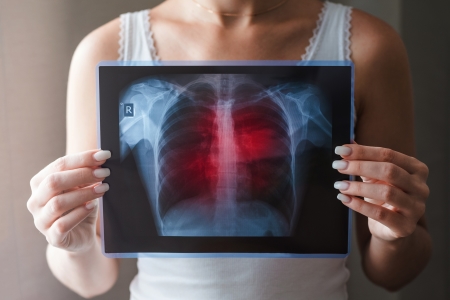Lung nodules sometimes cause patients deep anxiety. Let’s investigate the facts behind these abnormal growths.
They often show up when you get an x-ray for other another condition. These growths look like spots or shadows on the lungs.
However, did you know that many people have lung nodules and no worries? That’s because 95 percent of lung nodules are benign. Thus, they are not generally cancerous. Abnormal, yes. Cancerous, not usually.
Lung Nodules Come from Past Respiratory Illnesses

Worried About Spots on Your Lungs? Remember, Only 5% of the Cases Are Cancerous.
They often result from severe respiratory illness or several such infections over the years. Most importantly, most lung nodules do not even require treatment.
Lung Nodules (Abnormal Growths)
Let’s take a look at the 5 Traits of these abnormal growths. FLASS believes you should know the basic facts of these growths.
- According to the Cleveland Clinic, “You may have one nodule on the lung or several nodules.” Likewise, you could develop nodules in one lung or two.
- We reiterate that most lung nodules are benign. Likewise, they only rarely indicate lung cancer. Additionally, almost half of the “adults who get chest X-rays or CT scans have them.”
- You might hear doctors call these growths by different names. They are also called “coin lesions” or “shadows” on a lung.
- Healthline explains, “A lung nodule is a round or oval mass of cells that’s smaller than 30 millimeters (mm) (1.2 inches) in diameter.”
- To put it simply, they can range in size from a yellow pencil eraser or smaller to a golf ball. Additionally, it is the ones that show growth that might mean danger to your health. Your doctor will watch for the growth. Again, most of these growths do not typically grow. However, if they do, they might be cancerous.
Be Cautious but not Anxious with Lung Nodules
If pulmonary nodules are seen, your doctor still might want to evaluate you beyond x-rays. Such tests will determine if you have developed lung cancer.
And remember, the sooner lung cancer diagnosis is made, the more effective treatments are.
Lung Nodules: Several Types of Growths

Most Lung Nodules Are the Result of Previous Lung Infections.
As stated above, an infection or illness can inflame normal lung tissue. This often causes “a small clump of cells called a granuloma to form.
Then, as time goes by, “a granuloma can calcify or harden in the lung, causing a noncancerous lung nodule.” Below are some lung nodule definitions you might need to know.
1. Neoplasm: This is an abnormal growth of cells in the lung.
2. Neurofibromas: These are a type of noncancerous neoplasm.
3. Malignant or Cancerous Neoplasms include two types of lung nodules: the lung cancer type and carcinoid tumors.
Major Causes of Lung Nodules
Infections alone are not the only cause of these growths. Additionally, the below-listed factors can be major contributors.
1. Air irritants or pollutants can cause them.
2. Autoimmune diseases, such as rheumatoid arthritis and sarcoidosis frequently cause these types of nodules.
3. Fungal infections like histoplasmosis increase your chances of having lung nodules.
4. Scar tissue from illness or injury can cause them.
5. The most common cause, however, remains infections, especially frequent infections, in the respiratory tract.
Pulmonary Nodules: Know Your Risk Factors
First of all, be aware that anyone can get lung nodules. Secondly, without alarming you, FLASS wants you to know that cancerous nodules are more likely under the following conditions:
- Are you a former or current cigarette smoker?
- Are you older than 65?
- Check your family history. Do members of your family have cancer or did they die of such a diagnosis?
- Have you received radiation therapy in the chest?
- Were you ever exposed to asbestos, radon, or secondhand smoke? If you were, please discuss it with your doctor.
Moreover, if you answered any of these FLASS lung nodule questions with “yes,” you should talk to your doctor.
Symptoms That Might Worry You
First, understand that tiny lung nodules do not give you symptoms. However, if they are larger or pressuring your airway, you might develop coughing, breathlessness, and wheezing.
In rare but serious cases, you might develop signs of early-stage lung cancer. These signs are alarming. They include these bad elements:
You might have chest pain, chronic coughing, and coughing up blood.

Lung Cancer is Always the Worry When Abnormal Cells Are Detected. However, 95% of the Time, They Are Benign and No Treatment is Required.
Nodules and Lung Cancer Symptoms
Some patients feel overwhelming fatigue and hoarseness. Likewise, they have no appetite and have inexplicable weight loss. Recurring pneumonia or bronchitis is often diagnosed.
Diagnosis and Testing
Most people discover a lung nodule accidentally, after getting a CT or an X-ray.
Your doctor might want to monitor the lung nodules. Every 6-12 months you will need a CT scan. We know that “nodules that stay the same size during a two-year surveillance period are not likely to be cancer.” Then, you may be able to stop getting CT scans.
Next Steps in Defeating Serious Lung Nodules
Your doctor will examine you further if you have large or growing lung nodules. These tests could include the procedures listed below:
1. Bronchoscopy: You will be sedated. Then, your doctor will insert a catheter down your throat. Once the tube is in the lung, his instrument can capture a tiny specimen.
Subsequent lab tests will reveal if the cells are cancerous.
2. CT scan-guided biopsy: If your growths are on the outside of the lung, the doctor will use CT images to place a needle through your skin and into the lung. With the needle, he can take a sample from the nodule, and the lab will check for cancerous cells.
3. The Positron Emission Tomography (PET) scan: Also known as a PET scan, this test requires an “injectable radioactive chemical and an imaging device to detect diseased cells in organs.”
Removing Large or Cancerous Pulmonary Nodules
We have two types of typical surgical procedures to remove large or cancerous lung nodules.
1. Meet VATS, the Video-Assisted Thoracic Surgery
If you need a VATS procedure, the surgeon will insert a thoracoscope with a camera and minuscule surgical instruments. In VATS he will do this through some small chest incisions. Using the camera, your doctor can remove the nodules from your lung.
2. Thoracotomy:
In a thoracotomy, your doctor will make a larger-sized incision between your ribs and below the shoulder blade. He removes the lung nodule through the incision. After surgery, you will have a tube that “drains excess fluid from your chest.”
Terrific Take-Aways from FLASS

Protect Your Lungs From Abnormal Growths With a Healthy Lifestyle and Regular Checkups.
Terrific Take-Aways from FLASS
The idea of shadows on your lung X-ray can be disturbing. However, we reiterate that usually you need not worry about lung nodules. They are common, but the majority of them do not indicate lung cancer.
If a biopsy reveals cancerous growths, you and your doctor will discuss your specific surgical options.
By the way, we would be amiss if we did not warn you that you should stop smoking if lung nodules show up on your x-ray. And if you don’t smoke, don’t start. And to stave off your worries, just remember, “Fortunately, fewer than 5% of lung nodules turn out to be cancerous.”

